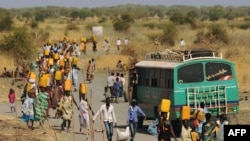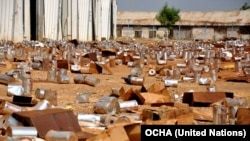Deputy Country Director for the United Nations' World Food Program (WFP) Eddie Rowe told VOA that at least 3.7 million people are in urgent need of food assistance in South Sudan, but relief has been delayed, largely because WFP does not have guaranteed safe access to all areas of the country.
“The roads are not safe -- a lot of checkpoints," Rowe said.
"Our transporters are being harassed, looted. The trucks are being looted. We do not have adequate partnership to engage with in providing these types of assistance. It is a mammoth challenge," he said.
The safety problems mean the WFP expects to reach fewer than 10 of 22 sites in Jonglei state, where 70 percent of the population of 1.7 million is "under acute and emergency food insecurity," according to the U.N. Office for the Coordination of Humanitarian Affairs (OCHA).
Most food-insecure people in South Sudan -- 90 percent -- are concentrated in three states that were hard hit by the fighting that broke out in mid-December -- Jonglei, Unity and Upper Nile states.
WFP warehouses in all three states were looted during the conflict, making the task of getting vital food assistance to those in need even more difficult, Rowe said.
"Not even our office is functional. We have to start from there, because that’s where we could deploy our staff. But more importantly, it is becoming increasingly difficult to move food to some of these locations where you have displacement, or even communities that are trapped that cannot move out,” he said.
Some 1,700 metric tons of food – enough to feed 102,000 people for a month – were looted from WFP's two warehouses in the Upper Nile state capital of Malakal during the course of the conflict, the aid agency says on its website.
WFP warehouses and offices have also been "cleaned out" in Jonglei and Unity states, it says.
"We’ve lost three major offices, each the size of a small country office,” Tommy Thompson, WFP’s emergency director in Juba, says on the website.
The loss of food stocks, offices, computers and other assets is "seriously complicating WFP’s response," Thompson said.
Further complicating the distribution of emergency food rations is the race to have supplies on the ground in areas that need aid before the rainy season starts, which is usually next month or April, at the latest.
Once the rains begin, many parts of the country will become inaccessible, aid groups say.
U.N. Food and Agriculture Organization (FAO) representative Sue Lautze said last week that “South Sudan was already the scene of one of the world’s largest humanitarian operations before the fighting began, and the situation is now deteriorating rapidly.”
“Markets have collapsed, infrastructure is damaged, foreign traders have fled, commodity supply corridors have been disrupted by violence, and rural populations are unable to bring their crops, livestock and fish to market for sale,” she said.
Mireille George, head of the International Committee of the Red Cross (ICRC) in Minkamen, said aid agencies were only able to deliver half-rations in January to the estimated 90,000 displaced who have sought shelter in the village on the White Nile in Lakes state.
"It’s been difficult for them... They have received half-rations for January. They have been sharing. It was not enough for sure,” she said.
But, she added, thanks to a convoy route that the ICRC has set up, the situation is improving in Minkamen, and the ICRC expects to be able in the coming days to provide a full month’s worth of food to the tens of thousands of displaced living in the makeshift camp.For South Sudan as a whole, Rowe said, the short-term outlook is "fairly gloomy."
Even the limited stocks of food that households were able to secure during the conflict are likely to run out in April or May, he said.
If insecurity causes farmers to miss the planting season, which starts next month, the country's acute food crisis could turn into a long-term problem, said the FAO's Dominique Burgeon.
“Missing the main planting season will have serious knock-on effects on food production and availability in the country in 2014 and on into 2015,” said Burgeon, the director of FAO’s Emergency and Rehabilitation Division, who recently visited South Sudan.
“At the moment, supply corridors have been disrupted or completely shut down in many areas of the country, and farmers need urgent assistance to access vital agricultural inputs in time,” he said.
Over the course of the year, seven million people in South Sudan, or around two-thirds of the population, are expected to face "some risk of food insecurity," according to OCHA, FAO and the WFP.



